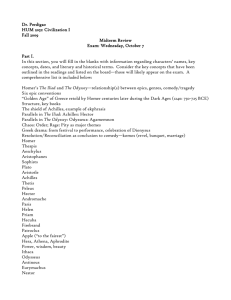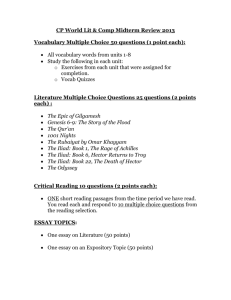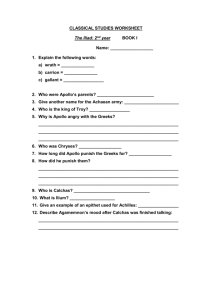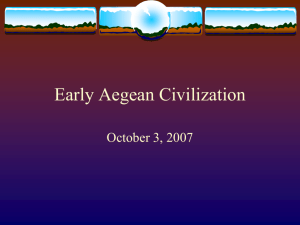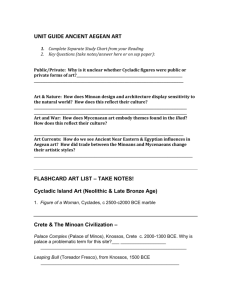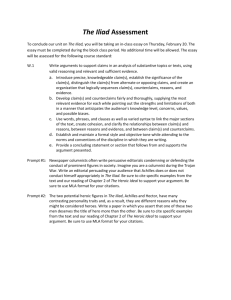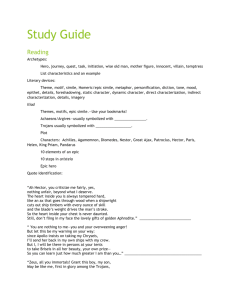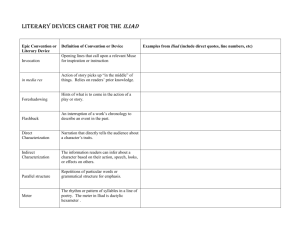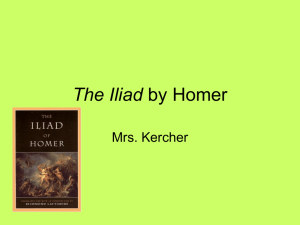Iliad
advertisement
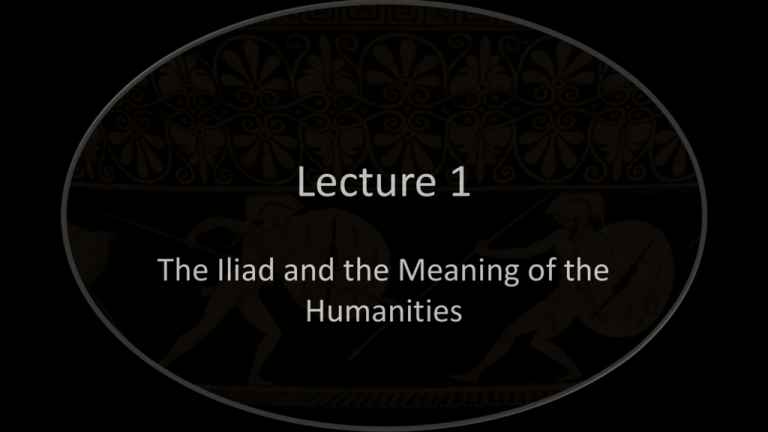
Lecture 1 The Iliad and the Meaning of the Humanities EPIC 1) A long narrative poem of heroic action Epic of Gilgamesh (Babylonian) 18th-10th century BCE The Iliad (Ancient Greek) 8th c BCE The Mahābhārata (Sanskrit) 4th c BCE Beowulf (Old English) 8th-11th c CE Beowulf (Old English) 2) Written in elevated language 3) With some foundational significance for the culture to which it belongs EPIC 4) For Classical epic (Greek and Latin), epic also names a characteristic meter Epic from epos: word or song Dactylic Hexameter Iliad I.1-16 (read by Gregory Nagy) • “Traduttore, traditore”— Translator, traitor • “Traduire c'est trahir”—To translate is to betray • “Poetry is what gets lost in translation” (Robert Frost) Parry-Lord Hypothesis 1. No “original text”– every performance is an invention 2. Composition is for an audience: speed and artistry matter; thus, repetition of formulas, scenes, and themes 3. Performances are sensitive to their audience, which can be expected to know the tradition Venetus A Homer (10th Century CE) —homermultitext.org Timeline of Ancient Greece • • • • • Mycenaean Period (1600-1100 BCE) : “Heroic Age” Dark Age (1100-700 BCE) : The Iliad Archaic Period (700-480 BCE) Classical Period (480-336 BCE) Hellenistic Period (336-146 BCE): Roman invasion of Greece Homer Might have lived 8th century BCE Possible birthplaces: Salamis, Cyme, Ios, Colophon, Thessaly, Smyrna, Thebes, Chios, Argos, and Athens Mythographically blind Bust of Homer: 1st-2nd Century BCE Cup, made in Athens, about 480 BCE: Briseus Taken (British Museum) The Parthenon: 438 BCE, Athens, Greece Nestor’s cup, Iliad 11.745-752 And there in the midst the grand, glowing cup the old king brought from home, studded with golden nails, fitted with handles, four all told and two doves perched on each, heads bending to drink and made of solid gold and twin supports ran down to form the base. An average man would strain to lift it off the table when it was full, but Nestor, old as he was, could hoist it up with ease. The Excavations of Troy • Excavated by Heinrich Schliemann in 1870 in Hisarlik, Turkey • Site is a “tell”—an artificial hill built of up layers of settlement • Most likely candidate for Troy of the Iliad: Troy VIIa, destroyed by war circa 1300 BCE Forms of Difficulty • Practical/Formal: establishing and accessing the text What is the Iliad? • Practical/Theoretical: determining the context What (when) is the Iliad about? • Conceptual: Who (what) are these people? "Those who cannot remember the past, are condemned to repeat it” vs. "The past is a foreign country: they do things differently there" Where are now the warring kings, Word be-mockers? -- By the Rood, Where are now the warring kings? An idle word is now their glory, By the stammering schoolboy said, Reading some entangled story: W.B. Yeats, “Song of the Happy Shepherd” (1889) Iliad, VI.171-175 Like the generations of leaves, the lives of mortal men. Now the wind scatters the old leaves across the earth,, now the living timber bursts with the new buds and spring comes round again. And so with men: as one generation comes to life, another dies away. Forms of Ease: the Iliad as a template for the present • Existential: “Like the generations of leaves, the lives of mortal men.” • Civilizational: “A free market, democracy, military dynamism, technology, free speech, and individualism, for better or worse, are what most on this earth desire. And what they desire started with the Greeks and the Greeks alone.” —Victor Davis Hanson, Who Killed Homer (1998) • Social Psychological: “I want to claim that the code of the streets, the heroic code, and the rules of Homeric society are nearly identical….[T]the epics allow us to see basic drives that exist within all of us, which Homeric society simply attempts to regulate rather than to disguise and suppress.” —Erwin Cook, “The Contemporary Relevance of the Illiad” (2013) University High School: Go Trojans! Troy, 2004 (Dir. Wolfgang Petersen) Iliad I.1-8 Rage—Goddess—sing the rage of Peleus’ son Achilles, murderous, doomed, that cost the Achaeans countless losses, hurling down to the House of Death so many sturdy souls, great fighters souls, but made their bodies carrion, feasts for the dogs and birds, and the will of Zeus was moving towards its end. Begin, Muse, when the two first broke and clashed, Agamemnon lord of men and brilliant Achilles. Iliad I.1-8 Rage—Goddess—sing the rage of Peleus’ son Achilles, murderous, doomed, that cost the Achaeans countless losses, hurling down to the House of Death so many sturdy souls, great fighters souls, but made their bodies carrion, feasts for the dogs and birds, and the will of Zeus was moving towards its end. Begin, Muse, when the two first broke and clashed, Agamemnon lord of men and brilliant Achilles. Iliad I.1-8 Rage—Goddess—sing the rage of Peleus’ son Achilles, murderous, doomed, that cost the Achaeans countless losses, hurling down to the House of Death so many sturdy souls, great fighters souls, but made their bodies carrion, feasts for the dogs and birds, and the will of Zeus was moving towards its end. Begin, Muse, when the two first broke and clashed, Agamemnon lord of men and brilliant Achilles. Iliad I.1-8 Rage—Goddess—sing the rage of Peleus’ son Achilles, murderous, doomed, that cost the Achaeans countless losses, hurling down to the House of Death so many sturdy souls, great fighters souls, but made their bodies carrion, feasts for the dogs and birds, and the will of Zeus was moving towards its end. Begin, Muse, when the two first broke and clashed, Agamemnon lord of men and brilliant Achilles. Iliad I.1-8 Rage—Goddess—sing the rage of Peleus’ son Achilles, murderous, doomed, that cost the Achaeans countless losses, hurling down to the House of Death so many sturdy souls, great fighters souls, but made their bodies carrion, feasts for the dogs and birds, and the will of Zeus was moving towards its end. Begin, Muse, when the two first broke and clashed, Agamemnon lord of men and brilliant Achilles.
